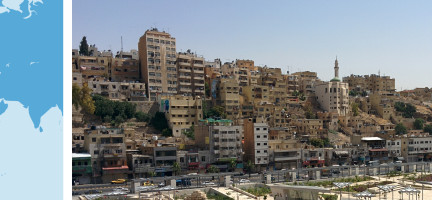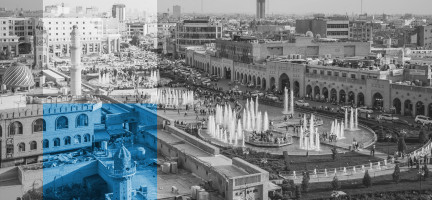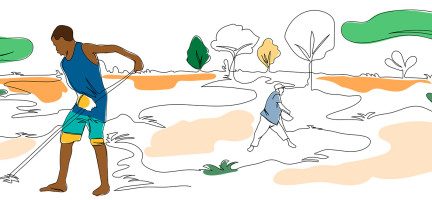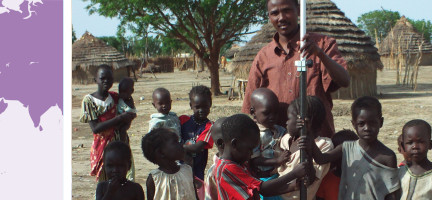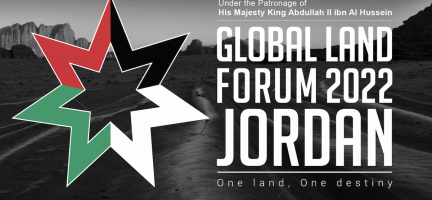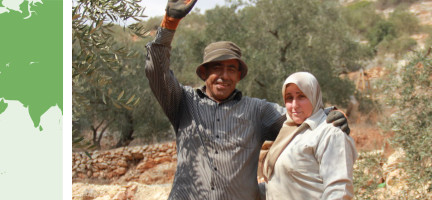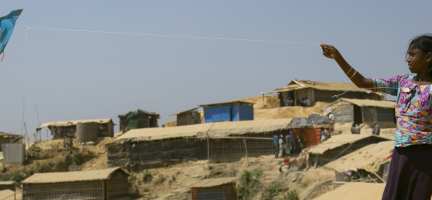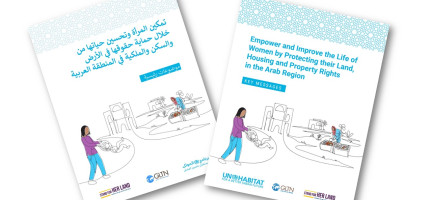Jordan
Page en construction!
Partagez avec l’Initiative Arabe sur le Foncier les documents, publications et autres informations qui peuvent être présentés ici. Écrivez à unhabitat-arablandinitiative@un.org
Legal and institutional framework
The establishment of Jordan’s first institution dealing with land registration can be traced back to 1857 when the Ottoman government created the Tapu[1], or land registry offices. The Ottoman government’s main objective was to develop a land inventory for taxation purposes. To this end it created the ‘Tapu books’, which documented information about the land, such as its value or rent (yield), its owner or beneficiary (user), neighboring owners, and a general description of the roads and geographical features it contained (Madanat, 2010). Based on the Treaty of Lausanne signed on 24 July 1923, the Emirate of Eastern Jordan obtained records and documents relating to private and public properties which were under the previous Ottoman land registration system. The government then commenced its attempt to reorganize the Ottoman cadaster. It issued the Land Liberation Bylaw and the Parcellation Law in 1923. In 1927, it issued the Land Liberation and Valuation Law. The name of the Department of Lands and Survey (DLS) appeared on 30 September 1927, under which the Department of Survey, the Department of State Property, and the Departments of land Registration and Land Liberation were merged into one entity.
Almost all rural areas were mapped and registered by 1950. Today more than 95 per cent of Jordan land is mapped and registered (Sayegh, 2016).
Modernization of DLS began in 1996 with support from the German government (GIZ) (DLS, 2018): between 1995 and 2001, all old maps and records were computerized (Sayegh, 2012). Between October 2011 and March 2013, the DLS successfully implemented a twinning project with Sweden (Lantmäteriet) and Poland (GUGiK), which included the development of three components: an integrated cadastral system, secured digital registers and maps, and accurate land valuation methods according to the best international practices (DLS, 2011). In 2016, the Jordanian Ministry of Planning and International Cooperation (MoPIC) signed a twinning project for the reinforcement of the real estate system in Jordan with the European Union (EU). The twinning project (2016-2018) also called "Reducing discrepancies between the physical reality and the graphical cadastral information in Jordan" was executed in cooperation with the governments of the Netherlands and of Sweden and falls under the EU Technical Assistance Framework. The project’s objective was to enhance the technical and administrative cadastral capacities of the DLS. It built upon previous EU funded efforts beginning in 1996 and envisaged development of a secure and integrated cadastral system including maps and land registers (USAID, 2018).
Official land stakeholders in Jordan are aware of land administration related challenges and constraints and have taken several steps to achieve a more efficient and sustainable land management administration and for protecting property rights. The recent modernization of the Department of Lands and Survey (DLS) has considerably enhanced its technical and administrative capacities in the field of cadastre and land administration. Moreover, Jordan has adopted several strategies and action plans covering housing, environment, the agricultural sector, combatting desertification, in addition to setting the national land degradation neutrality (LDN) targets and integrating LDN concepts and approaches in environmental and agriculture bylaws in the country to achieve the related Sustainable Development Goals (SDGs).
Despite the legislative reform, much land-related legislation in the country still needs to be reviewed to bring it in line with the new Real Estate Ownership law and to improve land management administration in Jordan. This includes the Jordanian Civil Law no. 43 of 1976, the Law of Planning of Cities, Villages, and Buildings, no. 79 for the year 1966 as amended (the urban planning law) and the Building Code no.7 of 1993 and amendments, among others. In addition, a housing law should be enacted as Jordan does not yet have one.
The current Jordanian Constitution ratified by King Talal on 1 January 1952 is protective of land rights. However, it does not provide for the right to water, the right to adequate housing, the right to be protected from displacement, the right to a safe environment and for ownership of the country’s natural resources by the people. Moreover, the Jordanian Constitution of 1952 does not mention sex or gender. Land laws are gender neutral and access to courts is guaranteed for all without discrimination on the basis of sex or on any other grounds. However, despite the availability of contracts and courts to protect their rights, many women are reluctant to use them, relying instead on family and tribal mediation, often under the influence of their male relatives.
In Jordan eleven ministries are engaged in various land-related functions. They are the Ministry of Finance (MoF), the Ministry of Local Administration (MoLA), the Ministry of Agriculture (MoA), the Ministry of Planning and International Cooperation (MoPIC), the Ministry of Public Works and Housing (MoPWH), the Ministry of Environment (MoE), the Ministry of Water and Irrigation (MoWI), the Ministry of Tourism and Antiquities (MoTA), the Ministry of Defense (MoD), the Ministry of Energy and Mineral Resources (MEMR) and the Ministry of Awqaf Islamic Affairs and Holy Places (MAISHP). In addition, the Prime Minister oversees the work of some of the departments and independent entities with land related functions (JOF, 2021).
Professional organizations such as Jordan Engineers Association (JEA) and the Jordanian Association for Real Estate Valuers (JAREV), private and cross-sector non-profit organizations such as the Jordanian Planning Forum (JPF), academic institutions such as the University of Jordan (UoJ) and financial institutions such as Jordan Mortgage Refinance Company L.T.D (JMRC) are important land stakeholders in Jordan, but the coordination between them and also between the state land related sub-entities is weak because of several constraints such as overlapping of responsibilities, data availability and access to information.
For more information and the references, see “Land, Housing and Property in Jordan: A review of the legal, institutional, and administrative frameworks” developed by UN-Habitat and GLTN in the context of the Arab Land Initiative.
Land tenure
The Jordanian land tenure system is comprised of a plurality of land rights that include statutory, customary (tribal), religious and informal rights. Private land, encompassing both miri and mulk, can be officially registered. Jordan’s rangelands and tribal territories, known as wajehat el-ashayeria, were historically governed by customary property rights. Religious land tenure, known as waqf, pertains to land endowed to religious institutions. There are also different types of informal land tenure arrangements, including squatters, hujja, tawsiya and informal rental arrangements frequently used by refugees.
Land and property registration is handled by the Department of Lands and Survey (DLS) under the Ministry of Finance (MoF). DLS is responsible for cadastral surveying, registration of land and property, and management of treasury (State) lands. Jordan has invested significantly in the modernization and improvement of its cadastral services, which led to an admirable improvement of its International Property Right Index ranking: the country is the 78th position (out of 190 countries), ahead of Egypt, Iraq and Lebanon and behind only UAE, Qatar, Oman, and Saudi Arabia in the Arab region.
Nonetheless, DLS still faces many challenges. For example, not all privately held land in Jordan is formally registered with DSL (World Bank, 2020). Registration of property is also constrained by the need to obtain a building tax clearance certificate from the relevant municipality beforehand (World Bank, 2020). There is also insufficient transparency withing the DLS, among other challenges.
The influx of refugees from neighboring war-torn countries has affected the land tenure of Jordanian citizens. The forced migration caused by the crisis in Iraq in 2003 and Syria in 2012 created high demand for rental housing and resulted in a sudden increase of houses and land prices beyond the financial capabilities of Jordanian citizens, created a gap between housing supply and demand and rendered owning a house more difficult due to the poor sustainability of housing credit support programs and the lack of small residential land plots (UN-Habitat, 2014). Syrian refugees in Jordan currently have the most precarious land rights, with those living in rented housing facing the highest risk of eviction and displacement. Many refugees live in rented apartments, but do not have formal and fair lease agreements, and therefore do not have security of tenure.
Women
There has been a positive trend in the protection of women’s land rights, such as the registration of properties in women’s names and combating the renunciation of inheritance. Efforts on this front need to be continued and enhanced, particularly to eliminate inheritance renunciation practices, increase women’s access to disputes’ resolution and rebalance gender dynamics related to access to, use of and control over land, housing, properties and other productive resources.
For more information and the references, see “Land, Housing and Property in Jordan: A review of the legal, institutional, and administrative frameworks” developed by UN-Habitat and GLTN in the context of the Arab Land Initiative.
Land use
Land use in Jordan is characterized by shifting land uses, primarily related to urbanization, leading to conversion of agricultural land driven by population growth, growing scarcity of water, and exacerbated by climate change. Only 11.9 per cent of the country’s total land area is categorized as agricultural and less than three per cent is arable. Less than 10 per cent of agricultural land is irrigated, and forests comprise a mere one per cent of total land uses (USAID, 2018).
For more information and the references, see “Land, Housing and Property in Jordan: A review of the legal, institutional, and administrative frameworks” developed by UN-Habitat and GLTN in the context of the Arab Land Initiative.
Land value
For more information and the references, see “Land, Housing and Property in Jordan: A review of the legal, institutional, and administrative frameworks” developed by UN-Habitat and GLTN in the context of the Arab Land Initiative.
Land development
In February 2024, Jordan endorsed its first National Urban Policy, developed by the Ministry of Local Administration in partnership with UN-Habitat. There are no recent national or regional plans yet or a national Geographic Information System, so all zoning and subdivision plans are created and approved without these tools. Public participation in the planning process is limited, as is the engagement of private sector actors in urban development in the country (UN-Habitat, 2015).
However, planning at the regional level is weak and there are no regional plans to enhance the development process. This is evidenced by the regional-urban disequilibrium, where only 40 per cent of the population live in Amman, yet more than 70 per cent of services and investments are concentrated in that city. This over-concentration of services in Amman contributes to the migration of investments from other Jordanian cities to the capital (Alnsour, 2015).
Physical planning at the local level is done by the departments of planning and organization in the Greater Amman Municipality (GAM) and all other municipalities in the Kingdom which are responsible for developing local plans for the city. In 2008, Greater Amman Municipality (GAM) approved the 2008 Amman Metropolitan Growth Plan as a base for the future development of the city. It aimed to respond to two major challenges: a projected growth of approximately four million new residents by 2025, and the continued flow of foreign capital into real estate development (Beauregard and Marplillero-Colomnia, 2011). Preparation for the 2008 Plan included the definition of policies and strategies, reviews of land policy, legislative frameworks and institutional arrangements and the creation of a participatory framework that aimed to address the planning concerns of all stakeholders. However, some planning experts argue that the 2008 Amman Metropolitan Growth Plan does not balance policy issues between Western and Eastern Amman. The quality of services and life in Western Amman, which hosts people belonging to the upper economic class, is better than that of Eastern Amman, which hosts people belonging to the working class and those with lower incomes (Alnsour, 2015), resulting in the phenomenon known as the “two Ammans” cityscape (Farhan and Al-Shawamreh, 2019). Effective urban policies are required to reduce this gap.
For more information and the references, see “Land, Housing and Property in Jordan: A review of the legal, institutional, and administrative frameworks” developed by UN-Habitat and GLTN in the context of the Arab Land Initiative.
Housing and informal settlements
With respect to housing, the Jordanian building sector is relatively strong; however, it is hampered by many impediments such as high land prices and excessive bureaucracy. Building permits are difficult to secure, and it is estimated that builders pay up to a third of a project’s value in taxes and fees (Brown, 2020). A study from 2018 conducted by the Housing and Urban Development Corporation (HUDC) on the effect of the new Amman Buildings and Zoning bylaw on housing costs found that GAM increased fees for housing building permits for all types of residential buildings to 3.5 times for residential buildings (D) and four times for popular housing, which is expected to result in increased housing costs (HUDC, 2018).
Another important challenge to providing housing to the market is low availability and high cost of land. Jordan does not have significant amounts of land in urban areas that has not already been built up. The available urban land that does exist consists largely of small parcels in isolated areas (USAID, 2018). Additionally, in 2017 the Jordanian government removed a previous hold on sales tax for many steel products used in construction, resulting in a tax rate increase from 8 per cent to 16 per cent for affected materials (WBG, 2018).
In 1980, in response to increasing housing demand in the country, the Jordanian Government established the Urban Development Department (UDD) which would be responsible for two key tasks: 1) implementing a program to upgrade squatter settlements, which involved improving the standards of the physical and social services and enhancing the living conditions of the target groups; and 2) implementing site and services projects for low-income households in the urban areas (AlDaly, 1999).
In 1989 Jordan adopted the National Housing Strategy (NHS) with the objective of enabling all citizens to have access to affordable housing. Based on the strategy recommendations, the UDD was merged with the Housing Corporation in 1992, forming the Housing and Urban Development Corporation (HUDC), regulated by law No. 28 of 1992. The HUDC became a fully independent government agency responsible for the housing and urban sectors. Its mandate includes providing housing to address the needs of different groups, in particular, low- and middle-income groups, reforming the housing sector, developing partnership initiatives with the housing private sector, and improving the living and housing conditions of the poor areas across the country (AlDaly, 1999).
On the legislative front, the Jordanian government took several measures to ease the burden of rising home prices on citizens such as exempting apartments with an area of less than 150 m2 from the property transfer and registration fee, applying reduced registration fees and tax until the end of 2021, introducing structural changes to the Landlords and Tenants Law to balance the relationship between owners and tenants and encouraging investors to invest in housing for the purpose of leasing (UN-Habitat, 2014).
A gender gap in housing ownership still exists in the country according to Jordan’s Department of Statistics (DOS). In 2014, Jordanian women owned 24.7 per cent of registered apartments (or 92,760 units), men owned 70 per cent (262,889 units), and the remainder was co-owned by men and women (5.3 per cent).
For more information and the references, see “Land, Housing and Property in Jordan: A review of the legal, institutional, and administrative frameworks” developed by UN-Habitat and GLTN in the context of the Arab Land Initiative.
Land dispute resolution
The formal justice system is the main mechanism for resolving land-related disputes in Jordan. It includes the regular courts, composed of the Peace courts and the First Instance Courts, the courts of Appeal and the Cassation Court, which is the highest judicial authority over regular courts (JJC, 2021). Special Courts managed by Regular Courts’ Judges also have jurisdiction over some specific land disputes determined by the law. These courts include Lands and Water Settlement Court, the State Property Conservation Court and the Municipalities Courts. The administrative justice system in Jordan is composed of the Administrative Court and the Higher Administrative Court (HAC). The Administrative Court has jurisdiction to receive any appeal or request for annulment against final administrative decisions, such as the decision of the Council of Ministers to expropriate a private land for public interest. Its decisions are open for appeal before the HAC (JJC, 2021).
With respect to alternative dispute resolution mechanisms, limited data on land disputes resolved through alternative dispute resolution mechanisms (arbitration, conciliation or mediation) is available. However, the Jordanian Arbitration Act No. 31 of 2001 as amended by law No. 16 of 2018 permits resolution of land related disputes through Arbitration. In June 2006, the first mediation center was established at the First Instance Court of Amman as a first step towards creating similar mediation centers in all courts in Jordan in accordance with the Mediation Law for the Settlement of Civil Disputes No. 12 of 2006 as amended by law No. 25 of 2017 (MoJ). Despite the use of mediation for several years, interest in mediation faded and it is no longer perceived as a reliable mechanism for dispute resolution. There is therefore a strong need to re-establish mediation as an effective dispute resolution mechanism in the country (IDLO, 2019).
Property rights over tribal land (or wajahat elaAshayeria) is a main driver of land conflicts in Jordan where tribal communities pre-date both Islam and the monarchy. Despite the laws that govern ownership, exploitation and investment of land, there has not been much advancement. Tribes like Beni Hassan and Beni Sakhar still claim ownership of tribal land, considering it as their land (ILC, 2017). In 2021, the issue emerged again in the course of ratifying the new draft law of State Land Conservation. Few members of the Jordanian Parliament believe that the passing of this law forecloses any solution to the problem of customary tribal land rights (Alarab, 2021).
For more information and the references, see “Land, Housing and Property in Jordan: A review of the legal, institutional, and administrative frameworks” developed by UN-Habitat and GLTN in the context of the Arab Land Initiative.
Implications of the Syrian refugee crisis on land tenure issues
The forced migration caused by the crisis in Iraq in 2003 and Syria in 2012 contributed to social and economic changes that have affected the housing market and infrastructure services. It created high demand for rental housing and resulted in a sudden increase of houses and land prices beyond the financial capabilities of Jordan’s citizens, created a housing gap between supply and demand, and rendered owning a house more difficult due to the poor sustainability of housing credit support programs, and the lack of small residential land plots (UN-Habitat, 2014). The increase in rent prices impacted access to affordable and adequate housing for both host communities and refugees, with 70 per cent of Jordanian households not able to afford adequate housing (JRP, 2020-2022).
Syrian refugees in Jordan currently have the most precarious land rights, with those living in rented housing at the highest risk of eviction and displacement. Many refugees live in rented apartments, but do not have formal and fair lease agreements, and therefore do not have security of tenure. Lack of appropriate lease agreements has led to evictions, rental increases, exploitation, and disputes with landlords. Further, one in ten refugees is living in an informal shelter, such as a tent, mud hut, or caravan. Almost half of refugees are living in shelters whose condition is classified as “bad or undignified.” Demand for adequate housing is manifest in sharp increases in land and housing rents and social tensions are on the rise. Such disputes can be both a cause and a consequence of tensions between refugees and host communities but must be addressed to prevent an escalation to violence (USAID, 2018).
The overall objective of the shelter sector of the Jordan Response Plan for the Syria Crisis 2020 -2022 (JRP, 2020 – 2022) is to ensure improved living conditions for vulnerable Syrian refugees and Jordanians through access to adequate, secure, and affordable housing in the host communities and formal settlements in Jordan. Support under the JRP, 2020-2022 has been provided in host communities and refugees’ camps.
Activities carried out in host communities: Targeted cash for rent assistance for extremely vulnerable Syrian refugees and Jordanians reaching around 7,000 beneficiaries; Shelter rehabilitation services combined with a rent-free and/or reduced rent amount lease agreement for 12-18 months period for extremely vulnerable Syrian refugees and Jordanians reaching around 16,029 beneficiaries; Installation of accessibility kits addressing various types of disabilities reaching 50 beneficiaries; 16,029 vulnerable people were provided with information and awareness on their right to adequate housing; and Vulnerable Syrian refugees and Jordanians benefiting from water connection to the municipality complied with awareness-raising sessions on adopting efficient water conservation-related practices around 5,850 beneficiaries supported.
Activities carried out in refugees’ camps: Upgrade and reparation of 6,637 shelters in Azraq and Zaatari camps; and Construction of kitchens for 4,652 shelters in Azraq camp (JRP-2020, 2022).
Key interventions
The successful collaboration between UN-Habitat’s Jordan Programme and Global Land Tool Network (GLTN) has created improved knowledge on tenure practices in urban areas with the Government, civil society and international actors, recognizing a “continuum of rights” approach for the urban poor.
Under the umbrella of the Arab Land Initiative, in partnership with the Global Land Tool Network (GLTN) and UN-Habitat, the Urban Training and Studies Institute (UTI) conducted an assessment of the land sector capacities in the region, reviewing the countries’ capacities to deliver good land governance through joint action by land institutions and stakeholders. This led to the publication of the background paper on the Jordan Land Sector Assessment by GLTN in 2023.
In 2022, UN-Habitat and GLTN produced a report on land degradation and conflict in Jordan, Sudan and Niger, building on work carried out by UN-Habitat and the Global Land Tool Network (GLTN) on land and conflict, including on Somalia and Sudan, which demonstrates the link between land degradation and conflicts. This is targeted at the broad community of experts and practitioners engaged in addressing land degradation, climate change, conflict resolution, peacebuilding and sustainable development.
As part of the programme to develop land governance capabilities in the region, the Urban Training and Studies Institute, under the auspices of GLTN and the Arab Land Initiative, conducted a study of the education and training courses related to land governance in numerous countries across the region, one of them being Jordan. The results of this were published in 2023. The study assessed the quantity and thematic coverage of the learning offered, identified the gaps and the opportunities for engaging with existing education and training institutions to complement the existing learning offer, and provided suggestions and directions for establishing more comprehensive curricula on land governance across the region. Jordan was one of the countries involved.
UN-Habitat supported the development of Jordan’s first National Urban Policy, developed by the Ministry of Local Administration in partnership with UN-Habitat.
Key documents and links
Dabash, D. (2023) Jordan Land Assessment: Background paper, GLTN and Arab Land Initiative
Egal, F. (2022) Land Degradation and Conflict: Case studies from Sudan, Jordan and Niger
Additional resources
UN-Habitat (2012-2021). Jordan Housing and Slum Upgrading. Project: Jordan Affordable Housing.
UN-Habitat (2012-2021). Jordan – Urban Issues.
Urbanet (2021). Infographics: Urbanisation and Urban Development in Jordan URBANET|May 6th, 2021,
USAID (2018). USAID Country Profile- Property Rights and Resource Governance Jordan June 2018.
WBG (2018). 2018 Economic and Sector Work – Jordan Housing Sector Review – Project P158331 May 2018.
Clause de non-responsabilité
Les informations contenues dans cette page sont basées sur l'ensemble des connaissances développées par ONU-Habitat, GLTN et les partenaires de l’Initiative Arabe sur le Foncier. Les désignations utilisées et la présentation du matériel n'impliquent l'expression d'aucune opinion de la part du Secrétariat des Nations Unies concernant le statut juridique de tout pays, territoire, ville ou zone, ou de ses autorités, ou concernant la délimitation. de ses frontières ou limites, ou concernant son système économique ou son degré de développement. Les informations peuvent contenir des inexactitudes en raison de la ou des sources de données et ne reflètent pas nécessairement les points de vue d'ONU-Habitat ou de ses organes directeurs.
La page de la Jordanie est encore en construction. Partagez avec nous toute information, ressource ou correction pertinente pour enrichir notre bibliothèque. Contactez l’Initiative Arabe sur le Foncier à unhabitat-arablandinitiative@un.org !
